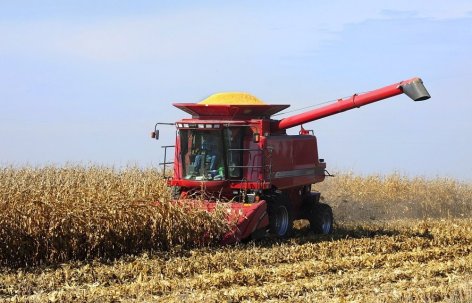
Agriculture experts at Iowa State University are watching closely to determine how this year's harvest will impact producers, consumers and the economy. Photo by Bob Elbert. Larger image.
AMES, Iowa – As U.S. farmers prepare to hit the fields for the 2014 grain harvest, agricultural experts at Iowa State University are available for media interviews.
Chad Hart, associate professor of economics and ISU Extension and Outreach grain markets specialist
Hart said this year’s harvest will present some challenges for farmers, but low yields won’t likely be among them.
“We know we’re going to be talking about big yields and big crops,” Hart said. “There’s not much doubt about that.”
The U.S. Department of Agriculture has been projecting record corn and soybean harvests this year, but the outlook for crop prices isn’t quite as rosy, Hart said.
“While producers are looking at big crops, they’re also looking at smaller prices and limiting revenue on a per acre basis,” he said. “Financially, things have gotten a lot tighter. That goes back to what we call the natural hedge. When supplies and acres and crops are up, prices decline.”
Hart recommended that farmers plan ahead and figure out what their “break even price” is. If a farmer intends to store grain in an effort to wait for better prices, Hart said the cost of storage must also be factored into the equation. Then, when the right price comes along, be aggressive.
“If there’s a price that looks attractive, get ready to lock that price in whenever you see it occur,” he said.
Mark Licht, cropping systems agronomist for Iowa State University Extension and Outreach
Licht said a portion of the crop that will be harvested in Iowa in the coming weeks may not have reached maturity, which could create complications for farmers and grain elevators. The crop immaturity is due to a late start to planting last spring and cool weather throughout the growing season, he said.
Delaying harvest to allow the grain to continue drying down is a risky proposition as lodging – or the collapse of top-heavy plants – and harvest losses become more likely as time goes on, he said.
“If we’re just getting into maturity now, in three weeks we’ll be in the first or second week of October, which brings frost risk,” Licht said. “Depending on when the killing frost comes, we may have it before we reach full maturity.”
Licht also said farmers need to be aware of some diseases striking the crop that could cause concerns, though he said it’s far from a crisis at this point.
“I don’t want to sound the fire alarm, but we’re at the stage where we need to be aware,” he said. “Some of the crop is struggling because of northern corn leaf blight, and Goss’s wilt in corn, and we’re seeing sudden death syndrome in soybeans killing crops a little bit early. We’re far enough along in development that those crops will mature but not necessarily get quite as much filled into the kernels and beans because it’s dying a little prematurely.”
Charles Hurburgh, professor of agricultural and biosystems engineering
Hurburgh, an expert on grain storage, said Iowa farmers may have dodged a freezing-cold bullet last weekend when the possibility of a frost didn’t pan out for the vast majority of cropland in the state.
“We got lucky,” he said. “Most of Iowa was about one degree warmer than necessary to cause significant frost damage.”
Iowa will produce more grain than it has the capacity to store if USDA yield projections are on target, he said. That means there could be storage crunches at grain elevators, leading to the possibility that some grain may have to be stored in uncovered piles outside.
Hurburgh said the 2014 crop’s test weight, or bulk density, will be higher than average, which will help corn to keep better in storage. But he also urged farmers to pay close attention to the moisture content of their grain. A wet crop creates the potential for mold damage when grain is stored, he said. He said a moisture content of 20 percent or greater is a cause for concern and requires efforts to dry the grain before storage.
He also said farmers and elevator managers who may still have some of last year’s crop in storage should replace it with this year’s grain.
“That might be a pain if you’re an elevator manager, especially during harvest season, but 2013 corn is nothing to keep for another year,” he said.
Elwynn Taylor, professor of agronomy
Taylor said crops can withstand a frost if the temperature doesn’t dip much below 32 degrees Fahrenheit. But if the temperatures drop to 28 degrees or lower, what Taylor refers to as a “hard freeze,” crops will likely halt their development.
In an average year in central Iowa, the first hard freeze usually occurs in mid-October. Northern Iowa typically sees a hard freeze several days earlier than southern Iowa, he said.
Hurricanes and tropical storms along the Pacific coast could cause some rain to ripple across the Midwest during the peak of the harvest, but Taylor said the National Weather Service is currently predicting the weather to be warmer and drier than average through the end of September and into October.
“That’s a relief for farmers to at least have that kind of weather in the forecast,” Taylor said. “That would give the crops more time to mature and could mean dry field conditions for tractors and combines as well as desirably low moisture content in the corn.”